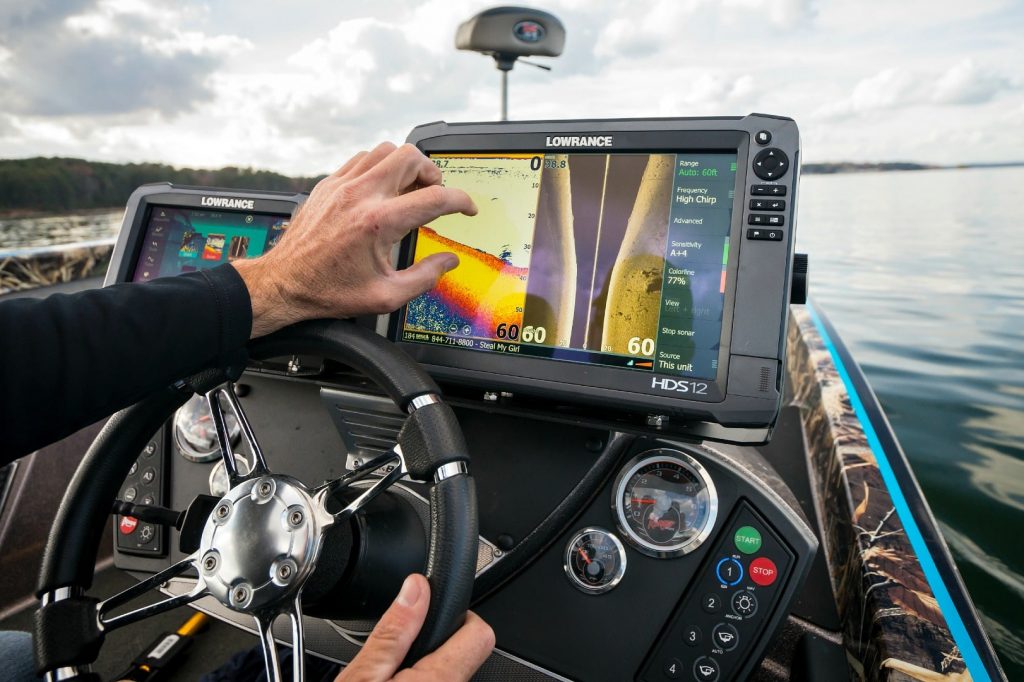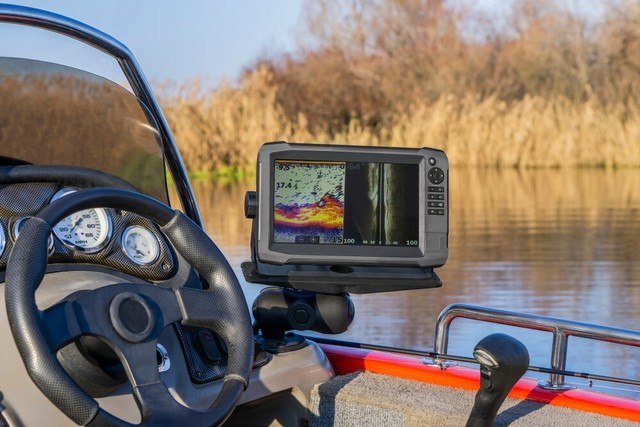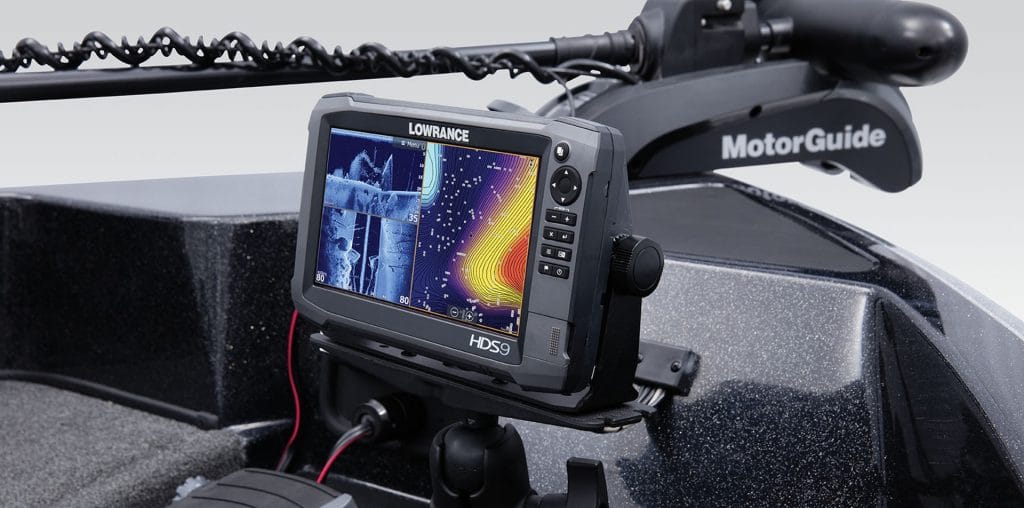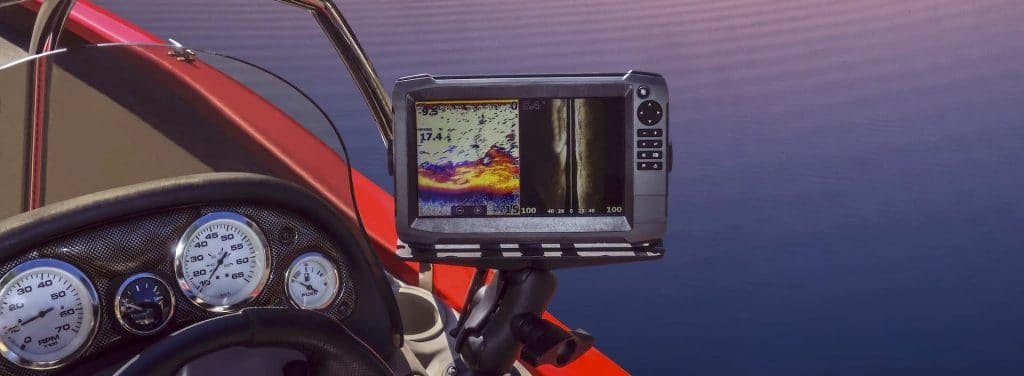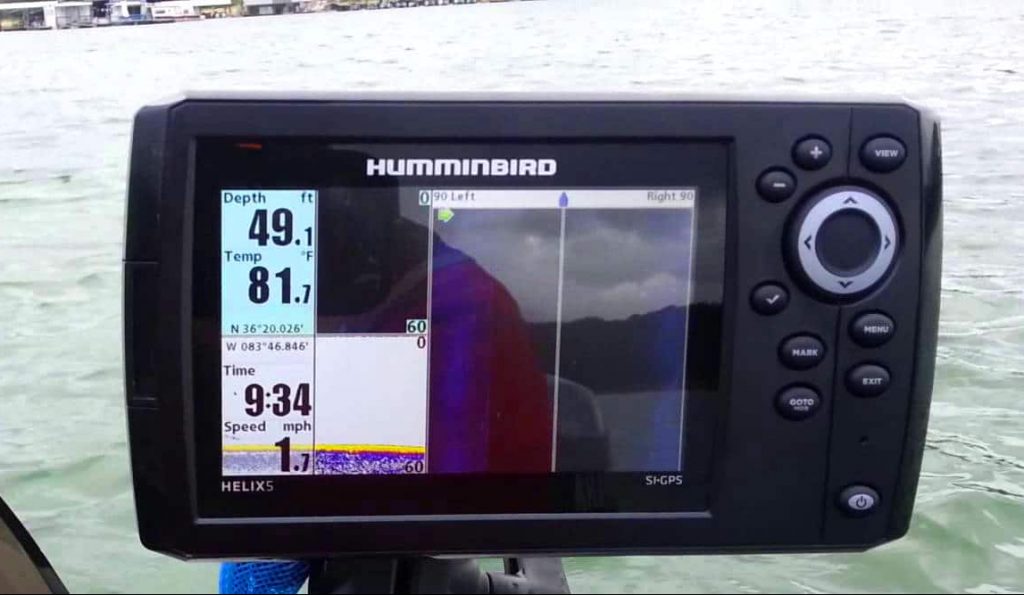

You can increase your chances of catching fish with the right gear such as the best Humminbird fish finder. Humminbird models are competitively priced and equipped with crystal-clear imaging, sizeable screen, and GPS navigation with detailed built-in maps of fishing spots.
We researched several products based on user reviews and individual features to narrow down to our recommendations. We factored in their maximum depth and reviewed the available controls for usability. All the models are time tested, reliable, and high-quality products. We have included models with CHIRP and Dual Beam sonar, as well as those designed for lake fishing and ice fishing. They come with different display sizes and overall dimensions depending on how much you’re ready to spend and what functionality you need. Our review of the best Humminbird fish finder also features a comprehensive buying guide that expounds on the most essential features and a summary of our top three picks.
More features: Micro SD card slot; built-in Anima cartography
Our Editor’s Pick is the bestselling Humminbird depth finder, with maximum depth capacity of 1,500 feet and down imaging capability for a clear view underneath your boat.
Humminbird HELIX 5 includes navigation aids such as GPS mapping with pre-loaded Anima cartography, AutoChart Live that lets you create your own fishing spots maps in real-time, and a micro SD card slot to save your maps and routes for future trips. LakeMaster is also available for buyers who upgrade.
It comes with a wide color WVGA screen of 5 inches and a CHIRP dual beam Plus sonar that generates readings with more details by combining coverage with precision so you don’t have to choose either.
CHIRP is an acronym for Compressed High Intensity Radar Pulse. Devices with this technology transmit and receive a broad range of frequencies that translate into greater separation of individual targets for clarity and accuracy. This model has target separation of 2.5 inches.
Buyers also receive a power cord, transducer, and gimbal mounting bracket.
What we liked: The outstanding depth capacity, side and down imaging, and the multiple preset settings to help anglers navigate in both familiar and unfamiliar water bodies.
What could be better: The mounting hardware could be better. The clips securing the cords are fragile because they are made of plastic, and some of the mounting brackets crack during installation.
More features: 800H x 480V resolution color TFT display; two display modes
For those upgrading to the best Humminbird fish finder, Humminbird HELIX 7 offers an ultra-wide 7-inch screen with high 800H x 480V resolution color TFT display and CHIRP dual frequency for broad or targeted search.
The GPS-enabled model boasts of MEGA down imaging in depths of up to 1,200 feet, and Switchfire sonar features two modes of display that read water depth and temperature, time, speed, and coordinates. It also tracks your lure and allows you to edit the information you want displayed. These settings are easily activated by pushing the buttons on the right side of the display. The selected settings can be viewed on a split screen so you can read more information at a glance.
Surprisingly, this unit only weighs 5.3 pounds despite the advanced features. Humminbird HELIX 7 comes in a package that includes a power cord, transom mount transducer, and mounting tools for quick installation. You may access more Humminbird LakeMaster maps with finer details when you upgrade the unit.
What we liked: What makes this model a contender for the best Humminbird depth finder is the preset navigation tools, side and down imaging capability with high resolution output, and the multiple display options that are tweaked with accessible buttons.
What could be better: The SI imaging with 180-degree viewing angle does not change colors, and the fish finder does not come with a memory card. The price, while worth it, may be too high for users with limited budget.
More features: Down Imaging; Tilt and Swivel mount
Humminbird PIRANHAMAX 4 is available in three different styles. The Series has been upgraded with an enlarged 4.3-inch LCD display with 272H x 480V, which is 70% additional pixels compared to its predecessor. The screen is backlit for visibility in dim conditions. It displays images from a maximum depth of 600 feet. The transducer transmits sound waves that generate sonar readings; with different colors signifying the strength of the signals.
Users can zoom in the images or adjust their contrast by utilizing the WhiteLine function that lets you replace other colors with white. For instance, you may want to replace the red hard bottom with white color to make the fish more visible on the screen.
It also features 3 different alarms and Fish ID+ function that displays fish icons according to their size so you can target a big catch. The fish alarm alerts you when fish is detected, and you can configure the size of fish that should trigger the alarm. The second alarm notifies you once the DualBeam sonar reaches a specified depth, and the third alarm is for low battery so you don’t suddenly run low on juice.
Other useful functions include down imaging and tilt and swivel transom mounting to adjust the viewing angle.
What we liked: It is the best portable Humminbird fish finder for the money with decent depth capacity of 600 feet and light weight of 2 pounds that suits kayaks, canoes, and small boats and. It is available with 3 alarms, down imaging function, and narrow and wide beam options.
What could be better: Although marketed as having GPS, it lacks that function as well as side scan imaging. The screen is also fairly small.
More features: LED backlight
Humminbird ICE-55 features a bright 3-color optic flasher, which displays information on the fish, lure, and the bottom in real time.
The screen is 526 Segment 6-Color Fiber Optic LCD Center. It is bright with LED backlight for easy reading in low light.
There are several controls for Zoom, Range, Gain, Beam, Noise, and Color Palette functions. We particularly like the Auto setting, which chooses the best range from the actual bottom depth to avoid guesswork. Humminbird ICE-35 does not have this Auto setting although it shares several features with this model.
Another unique feature of the Humminbird ICE-55 is the Color Key with 3 different color palettes for higher details. The third palette consists of 6 colors that indicate solar return signals at varied intensity; red, orange, yellow, light green, green, and blue.
This Humminbird ice fish finder utilizes double corded foam support system for support and signal. It comes with one lithium battery with high capacity, a carrying case with zipper, a dual frequency transducer.
What we liked: It has a competitive price for anyone seeking to upgrade their ice flasher and is designed to operate in temperatures as low as -20°F.
Owners like the inclusion of frequency noise rejection to limit interference with other fish finders, a demo feature for prior testing, dual beam for custom coverage, and 3 optional display colors.
What could be better: The main complaint regards the transducer cord loosening up when plugged or tangling with other fishing gear. For this reason, some buyers would prefer having self-retracting cords or one cord for both signal and support. This fish finder also lacks GPS functionality.
More features: 2X dynamic zoom
Humminbird ICE-35 has a flasher which provides a bright display that favors ice fishing where visibility is a problem. The flasher has green, yellow and red colors to indicate sonar intensity degrees, with red showing the highest level. This allows you to track the weeds and the fish as it approaches your hook. Flashers also discern between soft and hard bottoms. Users may adjust the flasher’s sensitivity to match their fishing environment.
It includes a user-friendly interface that incorporates control dials, including a large backlit flasher dial at the center, and a keypad with intuitive buttons.
It comes with a dynamic zoom feature with 2X magnification, a sizeable 526 segment 3-color fiber optic LCD center screen, and dual beam sonar with optional depth readings of 1X, 2X, 4X or 10X and reach of up to 200 feet. You may choose your preferred beam from the dual frequency sonar depending on the type of coverage you need; the 19 degree option for broader coverage and the 9 degree one for the highest definition.
Users receive a DVD with assembly instructions, a battery and the charger. The battery is durable with decent runtime of at least 8 hours. Some owners even operate the fish finder for days without having to recharge the battery.
What we liked: This is the best Humminbird fish finder for ice anglers. We like the bright flasher, user-friendly controls, large screen, and adjustable sensitivity and depth range. The fish finder also has optional demo to test and configure the features beforehand.
What could be better: It does not include GPS or a case for transport. Instructional DVDs may be inconvenient for users who prefer printed manuals for quick reference.
We have reviewed the most important features to consider before buying the best Humminbird depth finder so you can prioritize them according to your budget and needs. We have included an FAQ section that answers pertinent questions on components such as batteries, transducers, and memory cards.
You can get the best Humminbird fish finder for the money with all the essential functions you need as long as you know what to look for. Below are the features that will come handy as a shopping reference.
Humminbird fish finders come with displays that range in size and image clarity depending on the model. For example, Humminbird PIRANHAMAX 4 has a 4.3-inch LCD display with 272H x 480V while Humminbird HELIX 7 has a larger 7-inch screen with 800H x 480V resolution color TFT display. The latter displays data on temperature, water depth, speed, time and GPS coordinates that is viewable on optional split screen. Users can accurately track the fish, lure, and the lake bottom.
A large display would be useful to view a lot of fishing information and easy to read even in dim conditions. However, you should also factor in the numbers of pixels for a high resolution, greater clarity, and finer details, particularly for target separation in great depths. Target separation distinguishes between two objects that are in close proximity.
All Humminbird models feature colored displays that are convenient to read than black and white screens. Some even let you choose your favorite color from a variety of options.
It would be a waste of money to invest in a fish finder that barely allows you to view the lure, fish, structure, and the underwater topography. Our list of the best Humminbird depth finders feature maximum depth ranging from a minimum of 200 feet to Humminbird HELIX 5’s extensive reach of up to 1,500 feet, so you can select the right model for the water bodies you frequent. Some models even display the trajectory of the fish as well as its size so you can target big catches.
Other factors that may influence a fish finder’s depth capacity are the hardness of the bottom and the type of transducer you are using. Generally, these depth finders are more effective in fresh water than salty water, which is denser.
Humminbird incorporates CHIRP technology for dual beam sonar with two optional frequencies; low and high for different types of coverage.
Low frequency beams are suitable for reading deep waters. Unfortunately, the images are not as detailed since clarity and target separation reduces with increasing depth. High frequency units generate pictures with the best resolution. They are great at scoping shallow waters on moving boats. For deep lakes, consider Humminbird PIRANHAMAX 4 is available with 200 kHz and 455 kHz frequencies.
With Humminbird, you get the best of both worlds by combining the clarity of high frequency signals for targets in shallow water and the extensive deep water coverage provided by low frequency signals. A sweeping frequency with configuration of 50 KHz to 200 KHz is sufficient to cover both the breadth and depth of moderately deep bodies of water and return crystal clear signals that you can read easily.
Bear in mind that the frequency you choose will influence the transducer’s scope and viewing angle.
Thanks to smartphones, most people are already familiar with GPS, which refers to the Global Positioning System. This navigation system is found in some Humminbird fish finders to provide location information, including current time, speed and the specific coordinates.
As well as helping anglers locate the best fishing spots, GPS can pinpoint exactly where you are in case you are lost.
The transducer is an essential feature of the best Humminbird fish finder for the money because it is responsible for transmitting and receiving sonar signals. A good transducer will effectively isolate your targets and return high-quality images.
As mentioned earlier, the view of your transducer will be determined by the type of frequency in operation. Premium products are capable of side scan and down imaging. Side scan is ideal for broadening the view of the area around you, especially in shallow water. On the other hand, the best Humminbird depth finders are equipped with down imaging to scan the deep water beneath your boat.
Transducers are mounted in different ways. Transom mount are the most common because they are easy to set up; in-hull transducers are installed inside the boat and do not have to be in contact with water; thru-hull models produce high-quality images but they require drilling.
For small boats, canoes and kayaks, consider transducers that can be mounted on the stem of a trolling motor. This form of mounting is popular because it is easy to configure most standard transducers with an accessory kit that features hose clamps and brackets, among other set up tools.
When choosing the transducer, consider the size and design of your boat for compatible mounting.
Check the settings available with your device to confirm that they are what you need. A few Humminbird fish finders allow users to tweak the pre-programmed settings and edit the type of information they want to read. This offers users more control over output and reduces clatter on the display because they can opt out of some information. The controls should be accessible and easy to use. The featured products utilize dials and intuitive keypads to select and switch settings. Buyers receive instructional DVDs and user guide manuals for minimal learning curve. A couple of depth finders have demo function for prior testing of the device settings.
Humminbird HELIX 5 is a great illustration of this. It comes with integrated mapping with Anima cartography and AutoChart Live so you can generate your own fishing maps and save the data in a micro SD card. Humminbird also avails LakeMaster to its customers after they upgrade their fish finder devices. It contains a large database of maps of at least 10,000 lakes in North America and Canada. The maps feature highlighted depth ranges, water levels and shallow bodies ranging from 0 to 30 feet.
To identify the ideal size of your prospective fish finder, you need to check the size of your boat to ensure that the unit can be mounted without taking up much space or getting in the way. Fortunately, the models we have recommended come in varied sizes that are all manageable and relatively light weight for portability. The design of Humminbird products makes it possible for users to own compact units with large displays and advanced fish finder features.
Our top pick was an easy choice. Humminbird HELIX 5 boasts of side and down scanning and a maximum depth capacity of 1,500 feet that makes it the best Humminbird depth finder. The icing on the cake is the useful preset fishing maps and access to a larger database when you upgrade.
Humminbird HELIX 7 has plenty of impressive features that justify the price. It comes with a wide 7-inch color display with high resolution, dual frequency, GPS function, various display option, and a mounting kit for speedy set up.
If you are just starting out, Humminbird PIRANHAMAX 4 is the best Humminbird fish finder for the money because it is inexpensive and compact to fit in small boats and kayaks. It is capable of down imaging and reading the size of the fish. We also appreciate the 3 user alarms for low battery, specific depth and fish detection.

